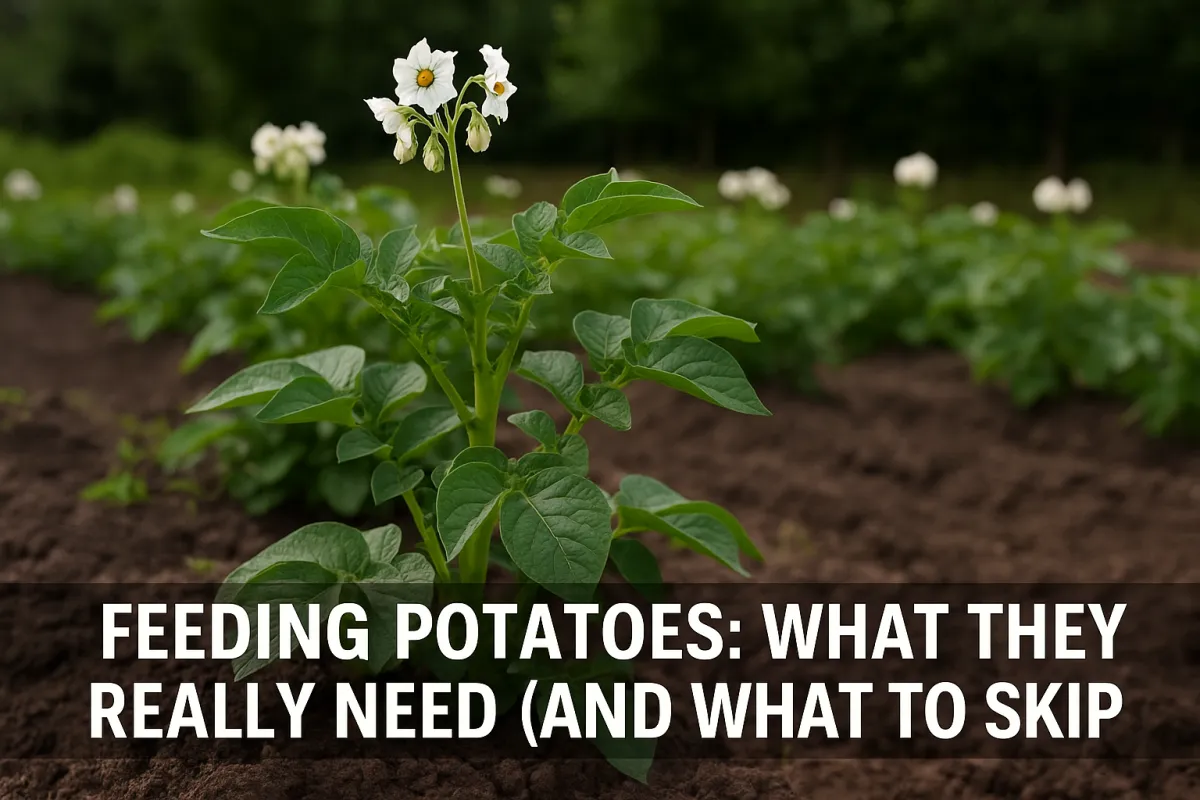
Feeding Potatoes: What They Really Need (And What to Skip)
Feeding Potatoes: What They Really Need (And What to Skip)
You ever grow a potato plant so lush and green, you’d swear it was going to feed a small army?
That was me—first real year growing potatoes on my own. The tops looked incredible. Thick stems, rich leaves, not a pest in sight. Come digging time? I pulled up four sad, undersized tubers. Grandma didn’t even blink. She looked at the plants, then at me, and said:
“You fed the leaves, not the roots.”
Turns out potatoes are picky—not in what they can grow in, but in how and when they’re fed. You can build perfect vines and still walk away hungry. If you want the kind of harvest that makes you feel like you’re doing something right, you need to feed smart.
Here’s what your potatoes actually need, when they need it, and what to skip if you want a solid yield and a long-storing crop.
What Potatoes Actually Need (It’s Not All Nitrogen)
Most beginners (myself included) fall for the same trap: they pile on compost or manure, hoping for a bumper crop. The plants shoot up, but the roots don’t bulk up.
That’s the nitrogen trap.
Potatoes do need nitrogen—but only early on, and only in balance. What they need most for tuber development is potassium and phosphorus. Potassium helps size and storage life. Phosphorus helps root and tuber formation. Nitrogen mainly helps foliage—and too much of it diverts energy away from the roots.
Before you feed anything, do a quick soil test. A basic $15 home kit can tell you a lot. Grandma used to sniff and squeeze her soil and knew just by feel. I like some numbers behind it, especially for phosphorus and pH.
When to Feed: The Three Key Stages
Timing matters more than quantity. If you feed heavy at the wrong time, you’ll grow more problems than potatoes.
1. Before Planting
Mix in aged compost, bone meal, and a bit of kelp meal
Adjust pH if needed (5.0–6.0 is ideal for preventing scab)
2. Mid-Growth (4–6 Weeks After Sprouting)
Side-dress with compost again
Add wood ash (for potassium) or liquid kelp
Avoid nitrogen-heavy anything at this point
3. Post-Flowering (Optional)
Only feed lightly if foliage starts to yellow early
No nitrogen now—this is tuber bulking season, not vine-building
🗓 Zone Tip:
Zones 3–5: Feed in late April to mid-June
Zones 6–8: Shift your feeding schedule about 2–4 weeks earlier
🌱 Container or Raised Beds?
Nutrients leach faster in small spaces. Feed lighter but more often, and focus on liquid amendments like compost tea or diluted fish emulsion.
What to Use: Organic Amendments That Actually Work
Here’s what I’ve had consistent success with—and what Grandma passed down:
Compost: Your baseline. Balanced, forgiving, and builds long-term soil health.
Bone Meal: High phosphorus, especially good at planting time.
Wood Ash: Rich in potassium. Use sparingly and only if your soil isn’t already alkaline.
Kelp Meal: Packed with micronutrients. Helps with stress, heat, and resilience.
Fish Emulsion: Use only early in the season and dilute it well.
🛑 Skip These:
Fresh manure: Too “hot” and invites scab. Let it age first.
Synthetic high-N fertilizers: Promote vines at the expense of tubers.
Uncomposted kitchen scraps: Nutrient imbalance and pest magnet.
💡 Grandma’s trick: She buried crushed eggshells and banana peels in the trench beneath her seed potatoes. Cheap, slow-release potassium and calcium.
What to Skip (And Why It Hurts Your Harvest)
Not everything labeled “good for plants” is good for potatoes. Here’s what to avoid if you want tubers that store long and grow even:
Too Much Nitrogen: Great for tomatoes, not for root crops. You’ll get huge tops and hollow harvests.
Fresh Manure: Introduces pathogens, burns roots, and throws off your soil balance.
Late Feeding: If you're still feeding once plants flower, you're delaying harvest and risking rot.
Wood Ash on High pH Soil: Raises your pH too much—hello, scabby potatoes.
Keep your pH around 5.0–6.0. That sweet spot discourages common scab and helps nutrient absorption.
How to Spot a Problem Before It Kills Your Harvest
Sometimes you don’t know something’s off until the leaves start talking. Here’s a quick visual guide to nutrient deficiencies:
SymptomLikely DeficiencyFixLots of green, few tubersToo much nitrogenBack off N, boost potassiumPurple leaf veinsPhosphorusAdd bone mealYellowing bottom leavesPotassium or nitrogenCompost or diluted fish emulsionMisshapen/scabby tuberspH or calcium imbalanceLower soil pH, add crushed eggshells
🖨 Print this chart and keep it in your shed. You’ll use it more than once.
Rotations, Companions, and What Comes Next
Good feeding doesn't stop at harvest—it shapes next season’s soil.
Avoid following potatoes with other heavy feeders like corn or squash
Good follow-up crops: beans (they fix nitrogen), leafy greens, garlic
Companions while growing: horseradish at row ends may improve vigor; calendula draws in beneficials
Avoid planting near: tomatoes, peppers, or eggplant—same disease families, tired soil
Bonus: Homemade Organic Boosters
Want to avoid store-bought inputs altogether? Here are a few homemade options:
Compost Tea: Brew 1–2 days and apply as a liquid side-dress
Banana Peel Tea: Soak peels in water 2–3 days, use for potassium
Wood Ash Water: For a pH-safe potassium boost (check soil first)
Eggshell Vinegar Soak: Steep crushed shells in vinegar for calcium-rich foliar spray
Use sparingly—your goal is support, not overload.
Final Thoughts: Feed the Soil First
Feeding potatoes isn’t about dumping fertilizer. It’s about building soil health, tuning into your plants, and understanding what the crop is actually trying to do.
As Grandma said, “The ground gives what it’s given.”
So give it well-aged compost, give it care, give it time—and it’ll hand back more than you planted.
“Build houses and settle in them; plant gardens and eat what they produce.” — Jeremiah 29:5
Keep growing,
The Grounded Homestead


Facebook
Instagram
X
Youtube